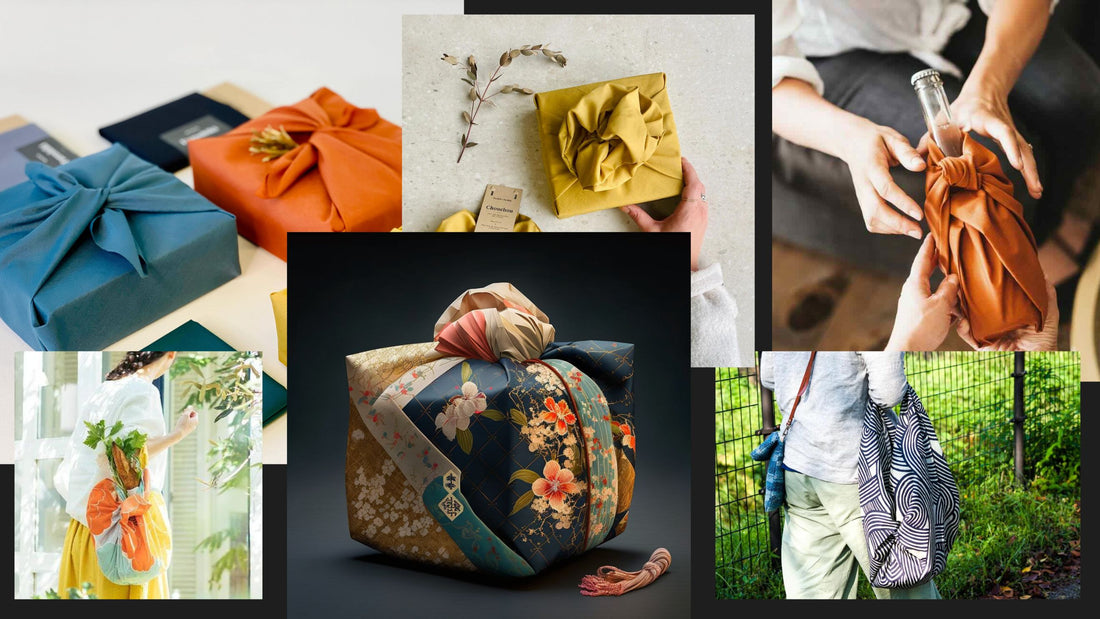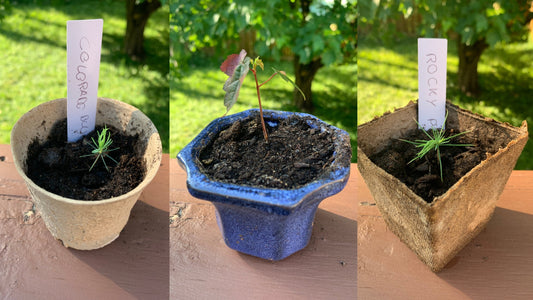The art of furoshiki , a term that may seem foreign to many, is nevertheless a centuries-old tradition in Japan. This Japanese term refers to a wrapping technique using a square of fabric, generally decorated with elegant and colorful patterns. Originally, furoshiki was used to carry clothing, gifts, and other items in a practical and aesthetic manner. Nowadays, this packaging method is growing in popularity outside of Japan, particularly due to its eco-friendly benefits and timeless beauty.
The main appeal of furoshiki lies in its commitment to sustainability. At a time when reducing plastic waste has become a global priority, adopting furoshiki is a simple but significant gesture for the environment. Unlike paper or plastic packaging, furoshiki is infinitely reusable, making it an eco-responsible alternative . In addition, it adds a personal and artisanal touch to each object it wraps, thus transforming the act of giving into a true aesthetic and emotional experience.
This article aims to immerse you in the fascinating world of furoshiki. We will explore its rich history and deep origins at the heart of Japanese culture. You will discover how this ancient tradition has evolved over the centuries and adapted to contemporary needs while retaining its essence. We will also highlight the many advantages of furoshiki, both ecologically and aesthetically, and we will provide you with practical advice for using it on a daily basis.
We will also introduce you to two exceptional partners who offer a beautiful selection of furoshikis. Olsen Olsen , a Quebec family business like ours, offers high quality furoshikis available for purchase online. You can explore their collection here: Olsen Olsen Furoshikis . Additionally, Wabi Sabi Shop , a renowned Japanese company, delivers its beautiful furoshikis to Canada and the United States. Discover their range here: Wabi Sabi Furoshikis .

Prepare to be inspired by the art of furoshiki and discover how this traditional technique can not only beautify your daily life, but also contribute to a more sustainable and environmentally friendly lifestyle. Whether you're a curious novice or a passionate lover of Japanese culture, this article will offer you valuable information and creative ideas for incorporating furoshiki into your life.
1. History and Origins of Furoshiki
The history of furoshiki dates back over 1,200 years to the Nara period (710-794) in Japan. Originally, these squares of fabric were used to wrap and transport clothing and other personal belongings in public baths. The term "furoshiki" itself is derived from "furo" (bath) and "shiki" (spread), indicating its initial use to protect bathers' clothing.
Over the centuries, furoshiki has evolved and diversified, becoming a central part of Japanese culture. During the Edo period (1603-1868), the use of furoshiki extended well beyond public baths. Traders used it to package their goods, and it quickly became a practical and stylish way to transport various items. Furoshikis from this era were often decorated with intricate designs and bright colors, reflecting the art and culture of the time.
With the Meiji era (1868-1912) and the rapid modernization of Japan, furoshiki saw a decline in popularity due to the introduction of paper packaging and plastic bags. However, it never completely disappeared. Rather, it continued to be used in specific contexts, notably for wrapping gifts during traditional ceremonies and events.
In recent decades, furoshiki has seen a resurgence, both in Japan and abroad. This renaissance is largely due to a growing awareness of environmental issues and a search for more sustainable lifestyles. The Japanese government has also played a key role in promoting furoshiki as an eco-friendly alternative to plastic bags. In 2006, Japan's Ministry of the Environment launched a campaign to encourage the use of furoshiki, highlighting its ecological and cultural benefits.

Today, furoshiki is not only a practical tool for packaging, but also a form of art and personal expression. Contemporary designers are creating furoshikis with modern patterns and varied materials, making this ancient tradition accessible and attractive to new generations. Whether for wrapping gifts, carrying everyday items or even as a fashion accessory, furoshiki continues to captivate and inspire with its elegant simplicity and versatility.
By understanding the history and origins of furoshiki, we can better appreciate its cultural value and potential as an eco-friendly alternative in our daily lives. It is a tradition that has evolved and adapted while retaining its essence, and which deserves to be rediscovered and adopted in the modern world.
2. The Advantages of Furoshiki
Furoshiki has many benefits that go well beyond its practical use as packaging. Its benefits span the environment, aesthetics and functionality, making this Japanese tradition a wise choice for those looking to adopt a more sustainable and stylish lifestyle.
Ecological advantage
One of the greatest benefits of furoshiki is its positive impact on the environment. Unlike single-use paper or plastic packaging, furoshiki is infinitely reusable. By using a furoshiki, we significantly reduce packaging waste, thus contributing to the protection of our planet. This ecological alternative also makes it possible to reduce the consumption of natural resources necessary for the production of disposable materials.
Versatility and multifunctionality
Furoshiki is incredibly versatile. It can be used to wrap gifts, carry bottles, create handbags, and even serve as a tablecloth or scarf. This multi-functionality makes it a practical and adaptable tool for a variety of everyday needs. Through simple folding and knotting techniques, a single piece of fabric can be transformed to suit multiple uses, making each furoshiki unique and personal.
Aesthetics and personalization
Furoshiki is not only functional, but also aesthetically pleasing. The fabrics are often adorned with beautiful patterns and vibrant colors, making each package a work of art in itself. This attention to detail adds a touch of beauty and refinement to anything wrapped in a furoshiki. In addition, it allows for great customization, with each furoshiki being able to be chosen depending on the occasion, the recipient or the type of object to be packaged.

Economy and sustainability
Investing in a few quality furoshikis can pay off in the long run. Being reusable, they replace many disposable items, saving money on single-use packaging purchases. Additionally, the durability of the materials used for furoshikis ensures that they can be used for many years, reducing the need for frequent replacement.
Cultural transmission
Using furoshiki is also a way of preserving and transmitting a precious part of Japanese culture. By adopting this practice, we participate in the conservation of an ancient tradition while adapting it to modern needs. It also provides an opportunity for education and awareness, sharing the history and techniques of furoshiki with future generations.
In short, furoshiki is much more than just a piece of fabric. It is a practice rich in meaning, respectful of the environment and blessed with great beauty. Adopting furoshiki in our daily lives means making a conscious choice for a more sustainable and aesthetic lifestyle, while honoring an ancestral Japanese tradition.
3. How to Use Furoshiki
Furoshiki, with its versatility and simplicity, offers a multitude of ways to transport, package and display items. Whether you're new to it or experienced, there are folding and tying techniques to suit every skill level. In this section, we'll guide you through the essential steps to mastering the art of furoshiki and provide you with practical tips for integrating this tradition into your daily life.
Basic Folding and Knotting Techniques
Learning basic folding and tying techniques is the first step to using a furoshiki effectively. Here are some simple ways to get started:
1. Otsukai Tsutsumi (Basic Wrap): This classic fold is ideal for wrapping rectangular objects like books or boxes. Place the object in the center of the fabric, fold in opposite corners, then tie the remaining corners on top of the object.
2. Bin Tsutsumi (Bottle Wrap): This technique is perfect for transporting wine bottles or other liquids. Place the bottle in the center of the fabric, fold the bottom corners around the base of the bottle, then tie the top corners around the neck.
3. Suika Tsutsumi (Packaging for round objects): Ideal for spherical or cylindrical objects, this method allows you to secure fruits or small gifts. Place the object in the center, fold all corners toward the center, and tie them tightly.

Illustrations and Tutorial Videos
To make learning easier, we recommend viewing detailed illustrations or tutorial videos. Many sites and YouTube channels offer step-by-step demonstrations that can greatly help visualize and understand the techniques. Don’t hesitate to explore these resources to improve your skills.
Choosing the Right Fabric
The choice of fabric is crucial for successful furoshiki packaging. Here are some tips for choosing wisely:
1. Size: The size of the furoshiki must be suitable for the object you want to package. A small furoshiki (50 cm) is suitable for small items, while a large furoshiki (70 cm or more) is needed for larger items.
2. Material: Cotton or silk fabrics are traditional and offer good durability and aesthetics. Cotton is ideal for everyday use due to its durability, while silk adds a touch of elegance for special occasions.
3. Pattern and Color: Choose patterns and colors that match the occasion and the recipient's personality. Traditional Japanese designs, such as cherry blossoms or geometric patterns, add a cultural dimension to packaging.
Integration of Furoshiki into Daily Life
Integrating furoshiki into your daily life is simple and beneficial. Use it to pack your lunches, carry personal items or even as an improvised handbag. You can also use it to give gifts in a unique and eco-friendly way. By adopting furoshiki, you are taking a step towards a more sustainable lifestyle while adding a touch of sophistication and Japanese tradition to your daily actions.
With these techniques and tips, you are ready to explore and experiment with the art of furoshiki. Remember, practice makes perfect, so have fun trying different methods and discovering everything furoshiki has to offer.
4. Furoshiki and the Japanese Art of Living
Furoshiki, beyond its practical usefulness, is deeply rooted in the Japanese art of living. It embodies values such as respect for the environment, simple and elegant aesthetics, and versatility in the use of everyday objects. This section explores how furoshiki fits seamlessly into Japanese philosophy and traditions, enriching our understanding of this ancient practice.
Simplicity and Aesthetics
Japanese aesthetics are often defined by concepts of simplicity, minimalism and natural beauty. Furoshiki perfectly reflects these values. With its clean lines and delicate patterns, it transforms even the most ordinary objects into elegant works of art. This attention to beauty in small things is a key characteristic of the Japanese art of living, where every detail is carefully considered and valued.
Respect the environment
Respect for nature and commitment to sustainability are at the heart of Japanese culture. Furoshiki, as a reusable alternative to disposable packaging, embodies this eco-friendly philosophy. By using a furoshiki, you adopt a more conscious and environmentally friendly lifestyle. This practice also encourages reflection on consumption and waste production, aligned with the Japanese principle of "mottainai", which expresses regret in the face of waste.
Versatility and Practicality
The versatility of furoshiki reflects Japanese ingenuity in maximizing the utility of everyday objects. A single piece of fabric can serve many purposes, demonstrating a pragmatic and innovative approach to everyday life. Whether wrapping gifts, carrying groceries, or serving as decoration, furoshiki easily adapts to various needs, providing a practical and stylish solution to many everyday challenges.
Transmission of Traditions
Furoshiki also plays an important role in the transmission of Japanese traditions and artisanal know-how. By learning and practicing folding and knotting techniques, we participate in the preservation of a rich and living cultural heritage. Additionally, giving a gift wrapped in a furoshiki is a gesture loaded with meaning, showing not only careful attention to presentation, but also respect for ancestral traditions.
Modernity and Cultural Integration
Although deeply rooted in tradition, furoshiki has evolved and adapted to modern life. Contemporary designers create furoshikis with modern patterns and materials, making this practice accessible and attractive to new generations. This ability to evolve while retaining its essence makes furoshiki a symbol of the Japanese art of living, capable of integrating into a global context while preserving its fundamental values.
In conclusion, furoshiki is much more than just a wrapping technique. It represents a philosophy of life that values simplicity, respect for the environment, and versatility. By adopting furoshiki, we embrace not only an ecological and aesthetic practice, but also a precious part of the Japanese art of living, rich in meaning and tradition. Whether for practical reasons or for its aesthetic appeal, furoshiki offers a multitude of ways to enrich our daily lives while honoring an ancient and venerable tradition.
5. Where to Buy Furoshikis
Whether you are an experienced furoshiki fan or a novice curious to explore this Japanese tradition, it is essential to know where to find quality furoshikis. Fortunately, there are many options for purchasing these versatile fabric pieces, from local craft boutiques to specialty online stores. In this section, we will present to you some of the best sources to buy furoshikis, highlighting companies that share our values of ecology and respect for traditions.
Olsen & Olsen: A Quebec Family Business
Olsen & Olsen is a family business based in Quebec that specializes in ecological and reusable products. Their collection of furoshikis is carefully selected to offer options that are both aesthetic and functional. By choosing furoshikis from Olsen & Olsen, you are supporting a local business committed to promoting sustainable and environmentally friendly solutions. Their furoshikis come in a variety of sizes, patterns, and materials, making it easy for you to find the perfect furoshiki for every occasion.
Wabi-Sabi: A Japanese Company Delivering to North America
Wabi-Sabi is a Japanese company dedicated to promoting traditional craftsmanship and authentic Japanese products. Their furoshikis, made in Japan, are a faithful reflection of Japanese quality and aesthetics. Wabi-Sabi ships not only to Japan, but also to Canada and the United States, making these magnificent furoshikis accessible to Japanese art lovers in North America. Their selection includes traditional and modern designs, suitable for various uses and preferences.

Local Craft Shops
Local craft stores are also great places to find unique furoshikis. Many local artisans create furoshiki using natural fabrics and traditional dyeing techniques. By purchasing from these stores, you directly support artisans and contribute to the preservation of traditional know-how. Look for craft markets, local fairs, or shops specializing in eco-friendly products to discover authentic, handmade furoshikis.
Specialized Online Stores
The Internet offers a plethora of online stores specializing in furoshikis, allowing you to easily find a wide variety of styles and patterns. Sites like Etsy bring together many independent creators who offer handmade furoshikis. You can also explore online stores dedicated to Japanese crafts or eco-friendly products to find high-quality options. When shopping online, be sure to check customer reviews and product descriptions to ensure you are getting authentic, well-made furoshiki.
In conclusion, whether you prefer to buy locally or online, there are many options for finding quality furoshikis. By choosing suppliers like Olsen & Olsen and Wabi-Sabi, you are supporting businesses committed to promoting eco-friendly practices and cultural traditions. Explore these sources and integrate furoshiki into your daily life to enjoy its many benefits while celebrating the Japanese art of living.
Conclusion
The art of furoshiki, with its deep roots in Japanese history, is much more than just a method of wrapping. It embodies essential values such as durability, aesthetics and versatility, while providing an elegant and eco-friendly solution for our daily needs. By adopting furoshiki, we embrace a tradition that values respect for nature, beauty in simplicity and practical innovation.
Furoshiki reminds us of the importance of considering every aspect of our consumption. By choosing reusable alternatives like furoshiki, we reduce our ecological footprint and contribute to a more sustainable lifestyle. This practice is not only beneficial for the environment, it also enriches our daily lives by bringing a touch of elegance and Japanese tradition to our simplest gestures.
The use of furoshiki is also a way of rediscovering and preserving artisanal know-how. By learning the different folding and knotting techniques, we participate in the transmission of ancestral knowledge and pay tribute to the artisans who perpetuate these traditions. Additionally, by offering a gift wrapped in a furoshiki, we add a personal and meaningful dimension to our gifts, showing our care and respect for the recipient.
Furoshiki is versatile and adapts to a multitude of situations, whether for wrapping gifts, transporting personal objects or even decorating our interior. Its flexibility and beauty make it a valuable ally in our quest for a more harmonious and aesthetic lifestyle. By integrating furoshiki into our daily lives, we are choosing to return to essential and sustainable values.
Finally, finding quality furoshikis is now easier thanks to companies like Olsen & Olsen and Wabi-Sabi shop, which offer a carefully curated selection and deliver to Canada and the United States. Whether you choose to buy locally or online, you're supporting eco-friendly initiatives and artisans dedicated to preserving traditions.
In conclusion, the art of furoshiki is an invitation to adopt a more conscious and respectful approach to our consumption. It is a celebration of beauty, simplicity and sustainability, rooted in an age-old tradition that continues to adapt and thrive in the modern world. By choosing furoshiki, we integrate a precious part of the Japanese art of living into our daily lives, for a greener and more elegant future.






1 comment
Très bel article sur l’art du Furoshiki
cette technique d’emballage m’a beaucoup plu
j’ai offert à une amie un cadeau emballer dans un joli carré coloré elle a beaucoup apprécié
Merci à Ikigai-box pour toutes ces informations riches d’enseignement sur l’art japonais